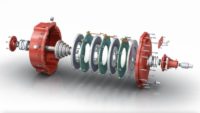EV Motor Market to Skyrocket Over Next Decade

SOUTHFIELD, MI—Rapid expansion in the electric traction motor market is on the horizon, driven by growing demand for e-axles and evolving technologies. A new report by S&P Global Mobility forecasts a fourfold increase in the e-motor market in the next 12 years, with expected production of more than 120 million motors by 2034.
Emerging technologies, such as e-beam axles that integrate motors and gearboxes, are gaining attention from companies that produce pickup trucks and vans.
Hairpin winding technology is also on the rise, due to its efficiency and power density, despite its intricate manufacturing process. It is anticipated to become the preferred choice for e-axle motors, with substantial growth in Europe and North America in the coming years.
Legacy OEMs are increasingly relying on in-house manufacturing to enhance e-motor technologies, reduce costs and improve product development time. Analysts at S&P Global Mobility project the majority of e-axle system integration will stay in-house until 2030. However, they claim that a new trend is emerging: OEMs are keeping design in-house, but are outsourcing the production of motors or their subcomponents, such as rotors and stators.
This is achieved through strategic sourcing or alliances and joint ventures. This approach is evident in Japan and Korea, with South Asia and Europe likely to adopt this trend by 2035. North America, however, is projected to maintain its focus on in-house sourcing.
In-house production of e-drive components is currently a major focus at General Moors and Mercedes-Benz, with both companies both investing heavily and planning to expand their factory capacities. Similarly, Hyundai and Renault-Nissan-Mitsubishi are shifting more toward in-house e-motor production, reflecting the industry's emphasis on cost optimization and maintaining supply chain resilience.
Electric motor suppliers such as Aisin, BorgWarner, Hitachi Astemo, Hyundai Mobis, Magna, Schaeffler and ZF are also ramping up production to meet increasing demand.
"Within just 18 months, [we have] doubled electric motor production from just under 1.5 million to 3 million [units]," explains Roland Hintringer, head of the electric motors product line at ZF. "Thanks to highly automated, volume-flexible and modular systems, we are able to serve our global customers as required.
"Our role as an innovator is also an important factor," adds Hintringer. “[We have] already announced that [we] will develop a magnetic-free electric motor—I²SM is a separately excited synchronous machine with inductive energy transfer—for volume production which, in contrast to the magnetic-free concepts available on the market today, is uniquely compact and has the highest power and torque density.
“[In addition, our] VSys800 electric drive is 35 percent lighter than current electric drives and reduces CO2 emissions in production and operation by 20 percent,” claims Hintringer. “Innovative stator winding technologies, a new cooling concept and the compact design make these major optimization leaps possible.”
Looking for a reprint of this article?
From high-res PDFs to custom plaques, order your copy today!







